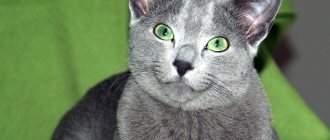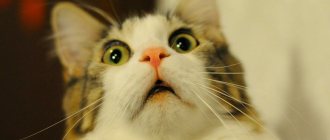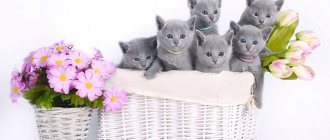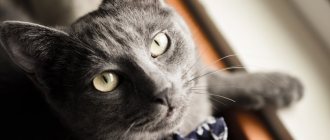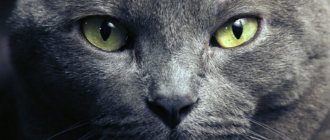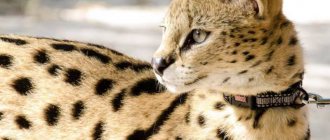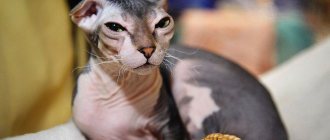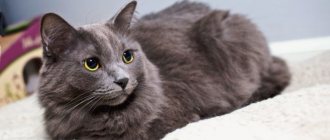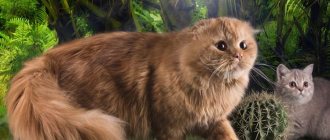| Origin | USA |
| Wool | middle length |
| Dimensions | weight 3.5-6.0 kg, height up to 25 cm |
| Lifespan | up to 18 years old |
Beautiful cats with a delicate smoky color of a silky coat have a proud name - Nibelungs. The mystical appearance matches the proud character of the animal. Relatives of the Russian Blue have the independence characteristic of a predator. At the same time, the Nibelung is an exclusively domestic cat breed that loves attention. Stroking these handsome dogs' luxurious fur is a real pleasure, and your pet will not resist this caress.
Key facts
According to the description, Nibelung cats are full of opposites. On the one hand, they simply adore their owners, on the other hand, they have a hard time getting used to new people and circumstances.
These conservative animals do not like to be left alone. They need company. Moreover, the role of a communication or play partner can be either a person or another pet.
Nibelung cats are great for families with children. However, they don’t really like kids who will pull their ears and tail. But a child over 6 years old will definitely become an excellent play partner for a mustachioed individual.
“A smart pet remembers commands well, so it can be taught different tricks.
The animal is unlikely to be suitable for beginners in cat breeding. The fact is that Nibelungs need quite complex care, which requires not only time, but also additional funds.
Advantages and disadvantages
- Beautiful appearance and color.
- Good health and strong immunity.
- Equilibrium.
- Friendliness towards the owners.
- Devotion.
- Intelligence.
- Need for careful care.
- Strict nutrition, exclusion of foods that will spoil the color of the coat.
- Tendency to obesity.
- Does not tolerate long absences from loved ones.
- Mistrust, poor adaptability to new conditions.
History of the origin of the Nibelung breed
Sometimes erroneously called the Russian Blue, the Nibelung is an entirely separate breed, although there are still some physical similarities.
The appearance of the breed occurred in the early 1980s. The “founder” of unusual pets was the short-haired black cat Elsa, owned by the son of Cora Cobb, a programmer from Denver, Colorado, USA.
In August 1984, the female gave birth to a litter of kittens, the father of which was a short-haired blue male. Both individuals apparently carried the recessive longhair gene, since one of the six newborns was a blue longhair male.
Cora Cobb kept this kitten and named him Siegfried in honor of the German warrior - a character in Wagner's opera The Ring of the Nibelung. The next year, Elsa gave birth to another litter from the same male, this time giving the world a long-haired blue girl. She, continuing the tradition, was named Brünnhilde in honor of the Icelandic heroine - the queen of the opera.
Cora Cobb moved to El Paso, Texas in 1985, taking Siegfried and Brünnhilde with her. In 1986, brother and sister mated and produced a litter of three long-haired blue kittens. Wanting to develop a breed of cats of this type, Cora Cobb took the advice of geneticist Dr. Solveig Pfluger.
He believed that the breed was best described as a Russian Blue semi-longhair. The breeder named the breed Nibelung, which in German means “creature of the fog.” At the same time, a standard appeared based on the distinctive features of the Russian Blue, with the only difference being the length of the hair.
“Russian blue breeders in the International Cat Association (TICA) objected to this, and the standard was revised.
First appearing at the TICA show in Paris in 1989, the Nibelung received champion status from TICA in May 1997. Representatives of this breed are currently recognized by several registration authorities around the world.
The Nibelung is still a rarity in Russia, but gradually there are more and more individuals of this breed in the country.
Nurseries
The Nibelung is a new breed and therefore very rare. Despite the large number of kennels of this short-haired relative, it will be difficult to buy a luxurious beauty with long smoky hair. Under no circumstances should you adopt a kitten based on a photo without documents, because the baby may turn out to be a reject or a Russian Blue mix.
In Russia there is only one official kennel of the breed - “Northern Star”, located in St. Petersburg. An experienced felinologist and a veterinarian with training as a geneticist-biologist are working to increase the population. New kittens appear regularly, but you can only purchase a furry baby after long-term reservation.
The famous French nursery “Bosse Marniere Fort” offers kittens of rare breeds, including Nibelungs. The German "NIMBATI" and the Italian "Muzgray" breed animals in parallel with the Russian Blue.
What does a Nibelung look like?
The Nibelung is an elegant cat with semi-long fur, soft and silky in texture and blue in color with a silver tint.
Muzzle
The Nibelung's head is wedge-shaped, widening at eye level. The pet's cheekbones are high. The ears are wide at the base, with pointed tips.
The eyes are quite large, almond-shaped, widely spaced. The color of the iris in adults should be green, as bright as possible. But kittens' eyes can be yellow.
In profile, the nose has a shallow concave curve.
The chin should be powerful, the bite should be even, and the mustache pads should be prominent. The pet's neck is long and slender. It may appear more powerful than it actually is due to the small but tight frill.
Body type
The body should be somewhat elongated. The build is medium to large, with strong muscles. Legs should be long, slender and elegant. However, the animal's bones are strong. The neat, round feet are covered with long hair between the toes and pads.
The tail is quite thick at the base, tapering towards the tip. This part of the body should be long enough to reach the shoulder blades.
Coat and color
The coat is semi-long, with a thin undercoat covered with denser guard hairs. The cover is dense, but soft and silky to the touch. It is desirable to have “pants” and tufts of hair in the ears.
The length of the coat and the density of the undercoat can vary depending on the time of year, and it can take up to two years for the "adult" coat to fully develop.
The color should be an even, medium blue, although kittens may have temporary striped markings. The silvery tint appears due to pigmentation at the ends of the hair.
The nose skin and paw pads should be blue, although a pinkish-lavender color is acceptable in kittens.
Disqualifying faults
Experts identify quite a few deviations from the standard, which can lead to the disqualification of an animal during competitions. The vices are:
- atypical pigmentation of the iris;
- round or square skull shape;
- stocky body;
- any other coat color except blue;
- almond-shaped or round eye shape;
- thick tail without thinning towards the tip;
- white points on the body;
- slanted eyes;
- coat that fits tightly to the body.
If the owners decide to undergo a brutal operation to remove the claws, then this will also become a serious disqualifying sign. From the point of view of the genitals, the main defect will be undescended testicles.
Description and standard
The breed is similar in size to the Russian Blue. Females weigh 3.5-4 kg, males weigh no more than 6 kg. At the same time, the height at the withers ranges from 20 to 25 cm. Animals create a feeling of grace and harmony.
Each Nibelung cat must meet strict breed characteristics:
- With medium dimensions, the animal’s body is stretched in length.
- The muscles are well developed, but do not create a feeling of massiveness.
- Long limbs with thin bones end in oval-shaped paws.
- The long tail is rounded towards the end.
- On a thin neck there is a flat wedge-shaped skull.
- The forehead and straight bridge of the nose meet at an angle at the line of the eyebrows.
- The whisker pads stand out on the muzzle.
- A strong jaw is characterized by a strong chin.
- The wide-set large eyes have bright green irises.
- The large ears are pointed at the end, tilted forward and set wide apart.
- The ears are thin and slightly pubescent.
Character of Nibelung cats
Attachment to the owner
Nibelungians are known for their affectionate, sweet temperament and soft “voice.” They may seem shy at first and may take some time to fully settle in.
This breed needs to be given time to explore and feel confident in new surroundings. Early socialization is very important for this breed.
Once in their new home, they form strong bonds with their human families, enjoying their company and affection. Cats will be happy to take part in games. However, they may be shy around strangers.
Relationships with children and other pets
This is a highly intelligent and quite energetic breed. Therefore, if they live only as indoor cats, they will need space to play and explore, as well as toys.
Mustaches also love to be entertained and stimulated. Cats don't like to be left alone for long periods of time. However, they need their own space to relax from games and socialize.
This good-natured breed will happily accept younger family members and dogs. Representatives of this breed are friendly to other cats. However, you should not leave them with poultry and rodents - in order to avoid awakening the hunting instinct.
Character and behavior
A mixture of contradictions is what comes to mind when mentioning the Nibelungs. They are gentle, but playful, ready to chase a paper ball until they drop, but are able to immediately calm down at the request of the owner. They make their way closer to the company, but are independent on their own and will never be a burden.
Individuals of this breed, like many other representatives of cats, choose for themselves one and only, the most important person, to whom they will obey. But, if the same Maine Coons or Orientals know how to be friendly with other family members, love them and be gentle with them, then the Nibelungs are not so simple.
For them, the rest of the family are essentially just service staff. Yes, his furry highness will deign to play with the proposed bow on a string, but he will not simply agree to closer contact. And even more so, you won’t be able to squeeze him or tickle him behind the ear. You will have to wait until the cat comes to you on its own, otherwise you will not be able to avoid a blow with a clawed paw or a dissatisfied grumble.
Nibelungs are an active breed, although at first glance they seem calm and even amorphous. Being in a good mood, the cat begins to jump, run and somersault, pushing off the walls with its paws and sweeping away everything in its path with its fluffy tail. They easily climb onto cabinets, quickly learn to open doors and drawers, and their natural curiosity makes them poke their nose into all corners of the apartment, boxes, jars and bags.
If the cat washes itself at the doorstep?
Guests will come to the money
However, such periods of violence among the Nibelungs do not happen so often. Therefore, these cats can be safely owned by elderly people, with a phlegmatic character, and families with adult children. Let's say especially about children: the child will have to explain that this cat is a person with a capital P, and he cannot be teased, poked or tried to be pulled by the tail. The Nibelungs remember all the insults very well and are just waiting for the hour to take revenge. They don't give any "discounts". Therefore, if you have a small child, you should not have a cat of this breed.
In addition, Nibelungs prefer a calm and even environment, in which there is no place for loud screams, loud laughter and other harsh sounds. Their noisy environment is very unnerving, making them irritable and grumpy.
Nibelungs prefer to behave carefully with strangers and strangers. When they see a guest, they hide in a secluded corner, or climb higher, and from there they carefully study those around them. They will not go into the hands of strangers, even if you promise them a treat, just as they will not allow themselves to be petted.
Nibelungs maintain quite friendly contact with other cats and dogs, but you definitely shouldn’t mix them with birds and small rodents - the Nibelung’s hunting instinct is very well developed.
Nibelungs are very smart and quick-witted, which means that you need to accustom the kitten to order from the very first day: go to the toilet only in the tray (we recommend reading the article When do kittens start going to the toilet?), scratch the claws on the scratching post and eat in a strictly designated place. Cats are quite capable of learning the commands “Lie down”, “Come to me” and “Fetch”, but you will have to be patient and under no circumstances force the cat. Otherwise, the effect will be exactly the opposite.
They rarely speak, preferring to communicate with their glances. They are clean, even beyond measure: they will not sleep on a bedding that does not seem clean enough to them. Like going into a dirty litter box. Moving from place to place and changing housing is difficult to bear.
Nibelungs do not tolerate being teased in vain, but they also cannot stand loneliness. Long absences from the “leader” are extremely painful. The cat protests against this as best he can: he refuses to eat, does not respond to the owner’s call, and very often does mischief: he ponds puddles, shits in a visible place, “marks” clothes or carpets. If you notice disorder and bad behavior, do not rush to scold your pet. Think about it: maybe he just misses you a lot?
Raising the Nibelung
A highly intelligent individual is highly trainable. It is quite easy to train babies to use a litter tray literally from the first days of their arrival in a new home. You just need to put him in the tray several times, and it is advisable to do this after feeding.
It’s so easy to teach a kitten or even an adult to use a scratching post. You need to run the animal’s paws over the useful toy, making it clear that it can be scratched. This must be done several times. Then the mustachioed pet will understand its purpose and will be happy to use it.
Thanks to their docile nature, cats are easy to teach a number of tricks. For example, animals happily jump through hoops and understand the commands “Down!” and “Sit!” Nibelungs can also bring things to their owner: balls, slippers or toys.
The main thing is that all exercises must be accompanied by affection and patience on the part of the owner. It's a good idea to use treats as a reward.
Looking for a Nibelung? Find your pet from 2 offers As a gift
general information
Cat with foggy fur. Nibelung.
- Nibelungs should be carefully and carefully looked after. For this reason, for beginners, this breed of cat may seem difficult to care for.
- Cats and cats of this breed are very amenable to training or new tricks.
- Experts do not recommend having Nibelungs if there are small children in the house. This breed of cat does not tolerate loud noises or bad treatment.
- Nibelungs are excellent hunters. For this reason, they are in no way suitable for keeping them in a small apartment with other types of animals, rodents or birds.
- Animals of this breed cannot withstand loneliness; they need to constantly have contact with someone, regardless of whether it is a person or a four-legged friend.
- Cats of this breed have a hard time surviving a move or a sudden change of environment. For the Nibelungs this is a great stress.
- The character of the Nibelungs is often complex. However, they will not show disobedience in front of their owner.
Health of the Nibelung breed
Possible diseases
The average lifespan of this breed is 11-16 years. However, with proper care and favorable circumstances, these cats can live more than 18 years.
The Nibelung is considered a healthy breed with no major problems. That's why it's a great choice for people who want to avoid veterinary costs.
To keep your cat healthy, visit the clinic regularly and do not forget about routine vaccinations. The only thing you should be wary of when it comes to this breed is hard growths in the bladder.
These rock-like deposits of minerals, crystals and organic matter form in a cat's body. Larger lesions block the urethra and prevent the pet from going to the toilet. Symptoms may include:
- blood in urine;
- pain when going to the toilet;
- frequent urination;
- meowing during bladder bowel movements.
Urolithiasis seriously affects the lives of cats, so a visit to the veterinarian and subsequent treatment is mandatory. Treatment varies depending on the severity of the disease. Surgery may be required to remove the stone.
Reproductive health and breeding
For breeding offspring, only purebred individuals without disqualifying defects and hereditary diseases are used. The Nibuleng breed has excellent health, but they should not begin early sexual activity.
The best time for mating a female and a male is considered to be about 1.5 years old. A litter can have from 4 to 6 kittens. Mating is best done on the groom's territory.
Health and illness
“Child of the Fog” is an extremely healthy animal, absolutely free of any genetic abnormalities or diseases characteristic of the breed.
The average lifespan is sixteen years. But the oldest Nibelung is officially recorded, who lived to be thirty-six years old.
The animal's nutrition should be properly organized to prevent overeating and obesity. It is mandatory to carry out deworming once every three months, and annually to vaccinate against viral infections and rabies. When traveling outdoors, do not forget about anti-flea treatment; it is most convenient to apply special drops to the withers once a month.
If the pet has calm living conditions, a balanced, nutritious diet, and an adored owner nearby, the “Child of the Fog” will delight the whole family with its love and devotion for many years.
Features of feeding and diet
Owners almost never have problems with what to feed the Nibelungs. These are not at all picky individuals; they happily eat both dry food and natural food.
The main product for a pet is meat. Animals need protein almost from birth. From 1-1.5 months, kittens can be given baby food made from chicken, turkey or rabbit. Cottage cheese and low-fat fermented milk products are excellent for feeding babies. The menu for both adults and kittens is diversified by boiled vegetables, which are chopped and added to food.
Contraindicated for feeding Nibelungs and all cats in general:
- buckwheat, liver and carrots (these products can change the color of the coat);
- pickled and salted foods;
- fat meat;
- tubular bones;
- River fish;
- sweets;
- smoked meats
When choosing dry food, preference should be given to high-quality premium or holistic products.
We must not forget that the animal must be provided with access to clean water. Moreover, boiled water can cause urolithiasis, so it is better to use bottled or filtered water.
Catering
Cats of this breed can be fed both natural food and commercial food. But remember: you will have to choose one thing, since doctors do not recommend giving the Nibelungs one or the other alternately. Balance, the required amount of minerals and vitamins - this is the main requirement for food. What can and should be included in the menu?
Natural products
- Meat: beef, veal, rabbit, chicken, turkey. Lamb meat is also allowed. But pork and duck meat are not allowed: they are difficult for a cat’s delicate stomach, and in addition, they are often infected with parasites. Meat should be given daily, after dousing it with boiling water and cutting it into pieces. Kids are allowed to make minced meat.
- Offal: hearts and ventricles, boiled liver (raw liver causes vomiting), chicken necks, ground into minced meat.
- Fish: only sea fish. These are salmon, hake, trout, sardines and other low-fat varieties. River fish can be toxic to cats. Give no more than once a week, since an excess of fish dishes leads to the development of urolithiasis (and Nibelungs are already prone to this disease). Shrimp and squid are allowed.
- Porridge: rice, oatmeal, buckwheat, pearl barley, millet. The porridge is cooked in water, only semolina is cooked in milk (liquid semolina is used to supplement kittens up to 3 months of age). Can be given 4-5 times a week.
- Vegetables: carrots, pumpkin, zucchini, green beans, cauliflower, greens (parsley, dill, spinach, lettuce), bran. Some cats happily eat vegetables raw, while others need to boil them and mix them with cereal or add them to meat broth. Add to the diet daily.
- Fermented milk products: natural yoghurts, kefir, fermented baked milk, sour cream, cottage cheese, yogurt, cheese. Products should be low-fat, free of dyes and other dangerous additives, preferably unsalted. Can be fed daily.
- Eggs: give whole quail eggs a couple of times a week, boil chicken eggs and feed only the yolk (you can give them 3-4 times a week).
- Oils: vegetable, olive, butter. They are added in small quantities (literally a few drops) to porridge.
- Sprouted oats or wheat. You can't give grass from the street!
Expert opinion
Dusheba Vera Ivanovna
In 2010, she graduated from the Moscow State Academy of Veterinary Medicine named after K.I. Scriabin with honors, specializing in veterinary medicine. I regularly attend veterinary conferences, congresses, and webinars.
Make sure your pet always has access to clean, cool water. It is changed regularly: in the mornings and evenings, and also when it gets dirty. It is recommended to buy bottled water, pass tap water through a filter, or let it sit for 6-8 hours. It is believed that boiled water increases the risk of developing urolithiasis.
Vitamin and mineral supplements are given only after consultation with a veterinarian, as is dry brewer's yeast.
Prohibited list of products:
- Pork, goose meat (both fillet itself and offal);
- Fatty fish, river fish - carps are strictly prohibited;
- Internal fat, lard, tripe, bones, skin;
- Sweets: chocolate, marmalade, marshmallows, marshmallows, etc.;
- Onion and garlic;
- Tomatoes, eggplants, potatoes, peas, chickpeas, mushrooms, sorrel, rhubarb, broccoli;
- Grapes, avocado, raisins, persimmons, citrus fruits;
- Seeds, nuts;
- Pasta, baked goods, salty, smoked, sweet;
- Raw chicken protein;
- Whole cow's milk;
- Coffee, tea, mineral water, alcohol, soda, juices;
- White cabbage;
- Sauces, mayonnaise, seasonings, spices;
- Dog food.
Kittens under 3 months of age are fed up to 6 times a day, from 3 to 4 months - 5 times, from 4 to 6 - 4 times, over 6 - 2 times, like an adult animal.
In the photo there is a kitten of the Nibelung breed
Food should be at a comfortable temperature: neither cold nor hot. Train your cat to eat in the same place, from its own dishes. It is advisable to wash bowls after each meal: Nibelungs are squeamish and will not eat from dirty dishes.
Recommended food
When choosing dry food, it is advisable to choose holistic and super-premium food. Economy class food does not bring any benefit to animals. And premium food in some cases causes allergic reactions. And the percentage of nutrients in both is too small. Feed samples: Innova Evo, Almo Nature, Pronature Original.
Below are recommended super-premium foods. Links with the names of the food are clickable, on them you can, within our website, get acquainted with the descriptions of the food and read reviews from owners of Nibelung cats.
| Premium | Super premium | Super premium |
| Bozita | Superpet | Organix |
Care and maintenance
Grooming
The wool of the Nibelung breed is their pride. However, it needs careful and regular care. Some owners spend almost an hour a day caring for their pet's fur. Therefore, if you are not ready for this, it is better to consider another breed as a pet.
In any case, the animal must be combed at least 2-3 times a week. A wide-tooth comb and a brush with natural bristles are suitable for this purpose.
The coat of Nibelungs sheds constantly, but this is especially noticeable in spring and autumn. Combing during these periods will prevent the formation of tangles and bald spots. In addition, your cat's hair should be thinned weekly using a furminator.
To prevent the noble color from turning red or brown, the fur must be protected from direct sunlight.
You shouldn't bathe your pet often. Even a special mild pet shampoo can negatively affect the quality of a mustachioed pet’s fur coat. Water procedures are indicated only for severe contamination. You can dry your hair using a hair dryer with cold air or a towel.
Hygiene
Check your pet friend's eyes and ears weekly for dirt and inflammation. Of course, you can do this more often. But once a week you need to wash the eyes and ears of the Nibelung with a special solution, which can be purchased at a pet pharmacy. You can also use warm boiled water for these purposes.
Your pet's teeth and gums need regular care. A special zoopaste and vein sticks will help keep your mouth healthy. If you find tartar, be sure to contact your veterinarian.
You can shorten the claws using a nail clipper. The procedure must be carried out as the claws grow, cutting off only the very tip.
Appearance
The Nibelung breed has the perfect structure for a cat. They are characterized by: an elongated and long body, high legs, a shaggy tail, a beautiful neck with a look similar to the mane of a lion and a convex muzzle.
Model of the Nibelung breed
Nibelung cat
Cats and cats of the Nibelung breed are naturally strong and robust animals. However, at the same time, cats have amazing elegance and grace. Nibelung cats are not particularly large in size from the cats themselves. The weight of the animal can be from 3 to 6 kg.
Although Nibelungs have expressive and beautiful silver hair, they are classified as semi-long-haired and small in size. Due to the thickness of their fur, these cats may seem short in stature, but this is not at all the case. Animals of this breed have a standard body structure.
Body type
Nibelung kitten on a walk
Long, standard structure, beautiful. The muscles are well built, it is athletic, but at the same time, surprisingly, it does not look too bulky. The base of the body seems not heavy and thin. Because of this, the silhouette of the cat looks graceful. The body itself is covered with thick and long hair.
Head
The cat's head is medium in size and wedge-shaped. Also, thanks to the long fur, the head itself can look round. The skull itself of this breed is flat.
Muzzle
The Nibelung's muzzle is slightly wedge-shaped and has light and soft features. And the transition to the forehead from the nose is clearly pronounced and has a practical right angle. The whiskers have an angular shape and create the appearance of a cat having a pouty muzzle. This feature of the Nibelungs can be clearly seen more in females. Their chin looks like a lion’s, strong and powerful in appearance. The nose itself is grey-blue.
Ears
Large with soft, rounded tips. They have a wide base and a slight slope. The ears themselves may seem almost transparent and delicate. Due to the hairiness they have poor hearing.
Eyes
This photo clearly shows the color of the cat's eyes.
They have an oval shape. And their size itself is average. They are widely spaced from each other, the outer corners are slightly raised up. The eye color of adult cats is green; you can rarely find a blue tint. Small kittens have yellow eyes. A complete change in the color of the cornea occurs by one year of a cat’s life.
Neck
It has a long and elegant shape. The mane, which is similar to a lion's, makes cats' thin necks appear shorter. In cats, the mane is much more powerful.
Tail
The Nibelungs' tail must be proportional to the body of the cat itself. At best, the length of the tail should be equal to the distance between the shoulder blades and the rump area.
The tail design itself is quite wide, but towards the end it tapers significantly. And the tip has a round shape.
Paws
They are quite long and moderately developed. The Nibelungen's feet are round or more often oval with a dense structure of the toes. Because of these features, it may seem that cats are walking on tiptoes. The empty space between the toes is filled with thick and beautiful hair. The color of the pads on the paws is gray-pink.
Size
Possible height is from 19 to 26 cm. The weight category of a cat starts from 4.5 kg to 6 kg, and a male from 6 to 8 kg.
Unique color and coat
Nibelung kitten
The coat of Nibelung cats is often not long, but rather has a normal, short length. In winter, it can become longer and fluffier, but in spring, on the contrary, it can shed and lose a significant amount of fur. The cat of the Nibelung breed has an extension in the area of the panties, namely on the hind legs. Cats' fur is fully formed by 24 months.
The color of the fur is predominantly blue, but it is not brightly saturated. Silvery shades can be seen due to the fact that the tips of the fur themselves are predominantly light in color. Scientists call this tipping. Soft and feather-light fur with a silver tint can make it look like your pet has a rare halo.
Tips for choosing a kitten
A purebred Nibelung kitten can only be purchased from trusted breeders. Since the breed is not widespread in Russia, a tempting offer to sell a baby below market value may turn out to be fraudulent.
Nibelung kittens are best purchased at 3 months of age. At this time, the main signs of the exterior are visible. By 3 months, it is clear what the baby will be like in terms of mental and physical health.
The color of a kitten may differ slightly from the adult standard, so you need to look at its parents. This way you will understand what your pet will look like in the future.
How to choose a kitten
Nibelung catteries exist in the USA and Europe, so you can buy a kitten abroad. However, it is worth considering that the price of the animal cannot be low. The minimum cost is $1000. Breeders of purebred cats in any country must be registered, and accordingly all babies will have documents confirming their belonging to the breed.
To buy a healthy cat that will subsequently be able to participate in exhibitions and breeding, you should:
- Check the pedigree of the baby and parents.
- Compare external signs with the established standard.
- Carefully study the terms of the contract.
- Assess the kitten’s appearance: appropriate behavior, mobility, clean mucous membranes, soft belly.
Don't worry if your baby's eyes don't have an emerald color, because the final shade of the iris is formed after 12-16 weeks of life.
Cat and cat, what's the difference?
Funny, thoroughbred Nibelung
The behavior and character of an animal depends on its gender. A special character trait of the Nibelung breed is manifested in their delicacy. These cats are particularly independent, but if you take this fact into account, they will still happily run to the front door if the owner comes. Also, animals of this breed are distinguished by their special devotion to the owner himself and no one else.
These cats can sense the mood of a stranger and will not impose themselves when they are not happy to see them. They do not strive to take first place or dominate the house, while they do not strive to oppress other pets or people, not at all. A cat can only demonstrate itself in all its glory.
Wool
Wool is the main advantage of the breed. Photos of Nibelung cats will certainly delight every animal lover. Thin and thick fur does not fit tightly to their body, which is why they resemble a small cloud.
Therefore, the name of the breed is translated as “child of the fog.” Color options range from light gray to dark blue with a silver tint.
Relationships with a person
Nibelungs instantly find a common language with a person. These are loyal and devoted pets that easily take root in the family. But problems can arise with strangers.
The animal does not trust strangers and is afraid of them, so leaving the cat for a long time with another person is unlikely to work.
